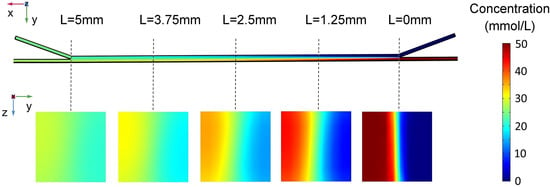A Diffusion-Based pH Regulator in Laminar Flows with Smartphone-Based Colorimetric Analysis
Abstract
1. Introduction
2. Simulation and Experimental
3. Results
3.1. Subsection Lateral Migration of Micro-Particles in this Laminar System
3.2. Concentration Profiles for Hydrogen and Hydroxide Ions
3.3. Continuous Spatial Gradient of pH along the Diffusion Channel
3.4. Regulating pH Values via Tuning Flow Rate
3.5. Regulating pH Values for Non-Neutral Streams
3.6. Smartphone-Based Colorimetric pH Detection
4. Conclusions
Author Contributions
Funding
Conflicts of Interest
References
- Cheng, L.-J.; Chang, H.-C. Microscale pH regulation by splitting water. Biomicrofluidics 2011, 5, 046502. [Google Scholar] [CrossRef] [PubMed]
- Lee, H.J.; Kim, J.-H.; Lim, H.K.; Cho, E.C.; Huh, N.; Ko, C.; Park, J.C.; Choi, J.-W.; Lee, S.S. Electrochemical cell lysis device for DNA extraction. Lab Chip 2010, 10, 626–633. [Google Scholar] [CrossRef] [PubMed]
- Rothberg, J.M.; Hinz, W.; Rearick, T.M.; Schultz, J.; Mileski, W.; Davey, M.; Leamon, J.H.; Johnson, K.; Milgrew, M.J.; Edwards, M.; et al. An integrated semiconductor device enabling non-optical genome sequencing. Nature 2011, 475, 348–352. [Google Scholar] [CrossRef] [PubMed]
- Toumazou, C.; Shepherd, L.M.; Reed, S.C.; Chen, G.I.; Patel, A.; Garner, D.M.; Wang, C.J.; Ou, C.P.; Amin-Desai, K.; Athanasiou, P.; et al. Simultaneous DNA amplification and detection using a pH-sensing semiconductor system. Nat. Methods 2013, 10, 641–646. [Google Scholar] [CrossRef] [PubMed]
- Maharbiz, M.M.; Holtz, W.J.; Howe, R.T.; Keasling, J.D. Microbioreactor arrays with parametric control for high-throughput experimentation. Biotechnol. Bioeng. 2004, 85, 376–381. [Google Scholar] [CrossRef] [PubMed]
- Zhang, Q.; Zeng, S.; Qin, J.; Lin, B. Microfluidic droplet trapping array as nanoliter reactors for gas-liquid chemical reaction. Electrophoresis 2009, 30, 3181–3188. [Google Scholar] [CrossRef] [PubMed]
- Luo, X.; Berlin, D.L.; Betz, J.; Payne, G.F.; Bentley, W.E.; Rubloff, G.W. In situ generation of pH gradient in microfluidic devices for biofabrication of freestanding, semi-permeable chitosan membranes. Lab Chip 2010, 10, 59–65. [Google Scholar] [CrossRef] [PubMed]
- Contento, N.M.; Branagan, S.P.; Bohn, P.W. Electrolysis in nanochannels for in situ reagent generation in confined geometries. Lab Chip 2011, 11, 3634–3641. [Google Scholar] [CrossRef] [PubMed]
- Wei, W.; Xue, G.; Yeung, E.S. One-step concentration of analytes based on dynamic change in pH in capillary zone electrophoresis. Anal. Chem. 2002, 74, 934–940. [Google Scholar] [CrossRef] [PubMed]
- Zhou, H.; Li, G.; Yao, S. A droplet-based pH regulator in microfluidics. Lab Chip 2014, 14, 1917–1922. [Google Scholar] [CrossRef] [PubMed]
- Gabrielsson, E.O.; Tybrandt, K.; Berggren, M. Ion diode logics for pH control. Lab Chip 2012, 12, 2507–2513. [Google Scholar] [CrossRef] [PubMed]
- Cabrera, C.R.; Finlayson, B.; Yager, P. Formation of natural pH gradients in a microfluidic device under flow conditions: Model and experimental validation. Anal. Chem. 2001, 73, 658–666. [Google Scholar] [CrossRef] [PubMed]
- Macounova, K.; Cabrera, C.R.; Holl, M.R.; Yager, P. Generation of natural pH gradients in microfluidic channels for use in isoelectric focusing. Anal. Chem. 2000, 72, 3745–3751. [Google Scholar] [CrossRef] [PubMed]
- Holzinger, D.; Ehresmann, A. Diffusion enhancement in a laminar flow liquid by near-surface transport of superparamagnetic bead rows. Microfluid. Nanofluid. 2015, 19, 395–402. [Google Scholar] [CrossRef]
- Alvariño, P.F.; Jabardo, J.M.S.; Agras, J.D.P.; García, J. Self-diffusion assessment in laminar developed flow of nanofluids in microchannels. Int. J. Therm. Sci. 2015, 98, 113–123. [Google Scholar] [CrossRef]
- Wu, Z.; Li, D. Mixing and flow regulating by induced-charge electrokinetic flow in a microchannel with a pair of conducting triangle hurdles. Microfluid. Nanofluid. 2007, 5, 65–76. [Google Scholar] [CrossRef]
- Babaei, F.H.; Zare, A.H.; Ghafarinia, V. Transient molecular diffusion in microfluidic channels: Modelling and experimental verification of the results. Sens. Actuators B 2016, 233, 646–653. [Google Scholar] [CrossRef]
- Sochol, R.D.; Sweet, E.; Glick, C.C.; Venkatesh, S.; Avetisyan, A.; Ekman, K.F.; Raulinaitis, A.; Tsai, A.; Wienkers, A.; Korner, K.; et al. 3D printed microfluidic circuitry via multijet-based additive manufacturing. Lab Chip 2016, 16, 668–678. [Google Scholar] [CrossRef] [PubMed]
- Bruzewicz, D.A.; Reches, M.; Whitesides, G.M. Low-cost printing of poly(dimethylsiloxane) barriers to define microchannels in paper. Anal. Chem. 2008, 80, 3387–3392. [Google Scholar] [CrossRef] [PubMed]
- Wang, S.; Ge, L.; Song, X.; Yu, J.; Ge, S.; Huang, J.; Zeng, F. Paper-based chemiluminescence ELISA: Lab-on-paper based on chitosan modified paper device and wax-screen-printing. Biosens. Bioelectron. 2012, 31, 212–218. [Google Scholar] [CrossRef] [PubMed]
- Lee, D.; Jeon, B.G.; Ihm, C.; Park, J.; Jung, M.Y. A simple and smart telemedicine device for developing regions: A pocket-sized colorimetric reader. Lab Chip 2011, 11, 120–126. [Google Scholar] [CrossRef] [PubMed]
- Nash, M.A.; Hoffman, J.M.; Stevens, D.Y.; Hoffman, A.S.; Stayton, P.S.; Yager, P. Laboratory-scale protein striping system for patterning biomolecules onto paper-based immunochromatographic test strips. Lab Chip 2010, 10, 2279–2282. [Google Scholar] [CrossRef] [PubMed]
- Yager, P.; Edwards, T.; Fu, E.; Helton, K.; Nelson, K.; Tam, M.R.; Weigl, B.H. Microfluidic diagnostic technologies for global public health. Nature 2006, 442, 412–418. [Google Scholar] [CrossRef] [PubMed]
- Martinez, A.W.; Phillips, S.T.; Whitesides, G.M.; Carrilho, E. Diagnostics for the developing world: Microfluidic paper-based analytical devices. Anal. Chem. 2010, 82, 3–10. [Google Scholar] [CrossRef] [PubMed]
- Yu, L.; Li, C.M.; Liu, Y.; Gao, J.; Wang, W.; Gan, Y. Flow-through functionalized PDMS microfluidic channels with dextran derivative for ELISAs. Lab Chip 2009, 9, 1243–1247. [Google Scholar] [CrossRef] [PubMed]
- Tohda, K.; Gratzl, M. Micro-miniature autonomous optical sensor array for monitoring ions and metabolites 1: Design, fabrication, and data analysis. Anal. Sci. 2006, 22, 383–388. [Google Scholar] [CrossRef] [PubMed]
- Suzuki, K.; Hirayama, E.; Sugiyama, T.; Yasuda, K.; Okabe, H.; Citterio, D. Ionophore-based lithium ion film optode realizing multiple color variations utilizing digital color analysis. Anal. Chem. 2002, 74, 5766–5773. [Google Scholar] [CrossRef] [PubMed]
- Soldat, D.J.; Barak, P.; Lepore, B.J. Microscale colorimetric analysis using a desktop scanner and automated digital image analysis. J. Chem. Educ. 2009, 86, 617–620. [Google Scholar] [CrossRef]
- Priye, A.; Ball, C.S.; Meagher, R.J. Colorimetric-luminance readout for quantitative analysis of fluorescence signals with a smartphone CMOS sensor. Anal. Chem. 2018, 9, 12385–12389. [Google Scholar] [CrossRef] [PubMed]
- Nogueira, S.A.; Sousa, L.R.; Silva, N.K.L.; Rodrigues, P.H.F.; Coltro, K.T. Monitoring acid-base titrations on wax printed paper microzones using a smartphone. Micromachines 2017, 8, 139. [Google Scholar] [CrossRef]
- Oncescu, V.; O’Dell, D.; Erickson, D. Smartphone based health accessory for colorimetric detection of biomarkers in sweat and saliva. Lab Chip 2013, 13, 3232–3238. [Google Scholar] [CrossRef] [PubMed]
- Lee, S.; Oncescu, V.; Mancuso, M.; Mehta, S.; Erickson, D. A smartphone platform for the quantification of vitamin D levels. Lab Chip 2014, 14, 1437–1442. [Google Scholar] [CrossRef] [PubMed]
- Park, T.S.; Li, W.; McCracken, K.E.; Yoon, J.-Y. Smartphone quantifies Salmonella from paper microfluidics. Lab Chip 2013, 13, 4832–4840. [Google Scholar] [CrossRef] [PubMed]
- Oncescu, V.; Mancuso, M.; Erickson, D. Cholesterol testing on a smartphone. Lab Chip 2014, 14, 759–763. [Google Scholar] [CrossRef] [PubMed]
- Roda, A.; Michelini, E.; Cevenini, L.; Calabria, D.; Calabretta, M.M.; Simoni, P. Integrating biochemiluminescence detection on smartphones: Mobile chemistry platform for point-of-need analysis. Anal. Chem. 2014, 86, 7299–7304. [Google Scholar] [CrossRef] [PubMed]
- Zeng, Z.; Zhang, K.; Wang, W.; Xu, W.; Zhou, J. Portable electrowetting digital microfluidics analysis platform for chemiluminescence sensing. IEEE Sens. J. 2016, 16, 4531–4536. [Google Scholar] [CrossRef]
- Shen, L.; Hagen, J.A.; Papautsky, I. Point-of-care colorimetric detection with a smartphone. Lab Chip 2012, 12, 4240–4243. [Google Scholar] [CrossRef] [PubMed]
- Al-Baldawi, N.F.; Abercrombie, R.F. Cytoplasmic hydrogen ion diffusion coefficient. Biographys. J. 1992, 61, 1470–1479. [Google Scholar] [CrossRef]

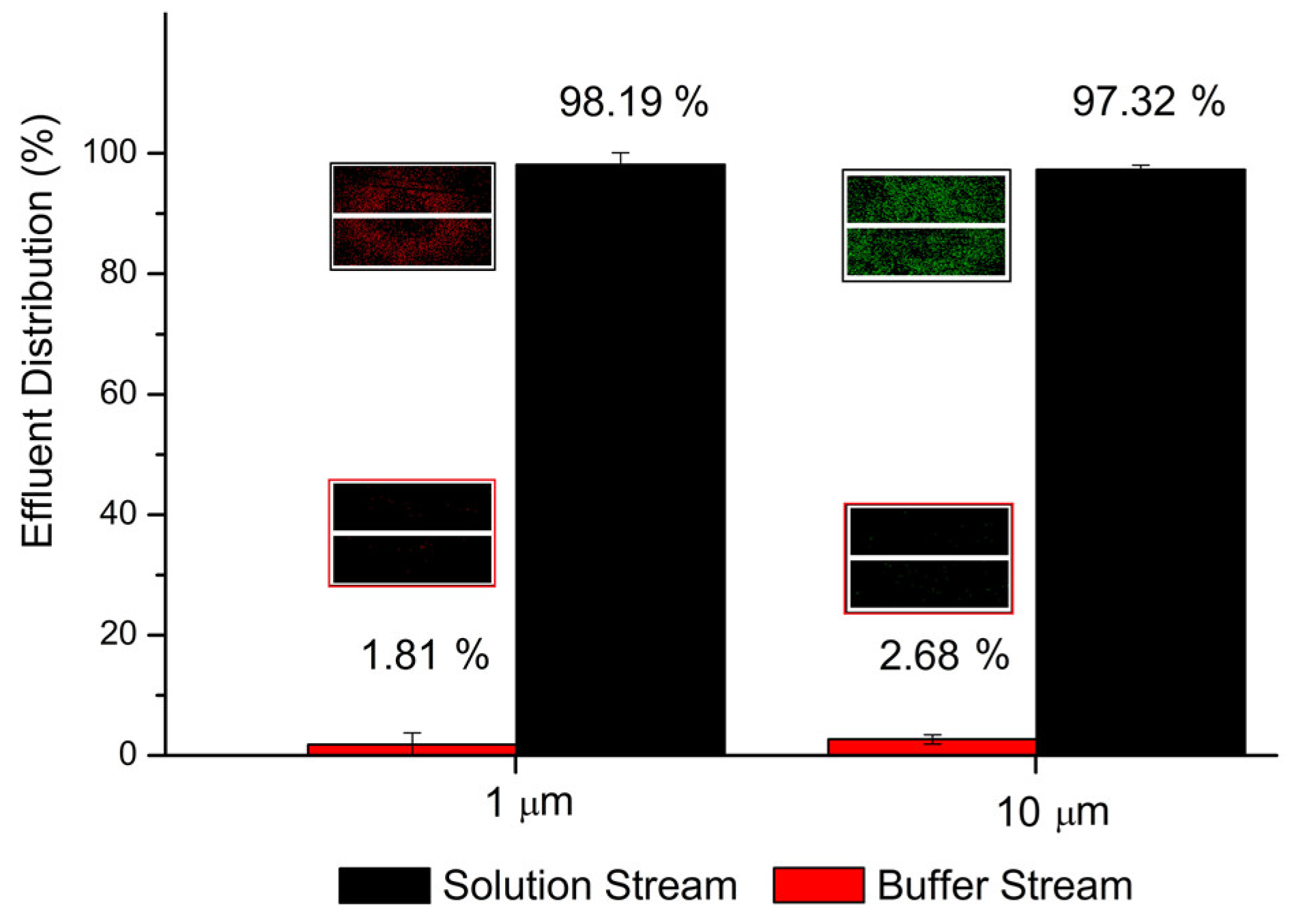
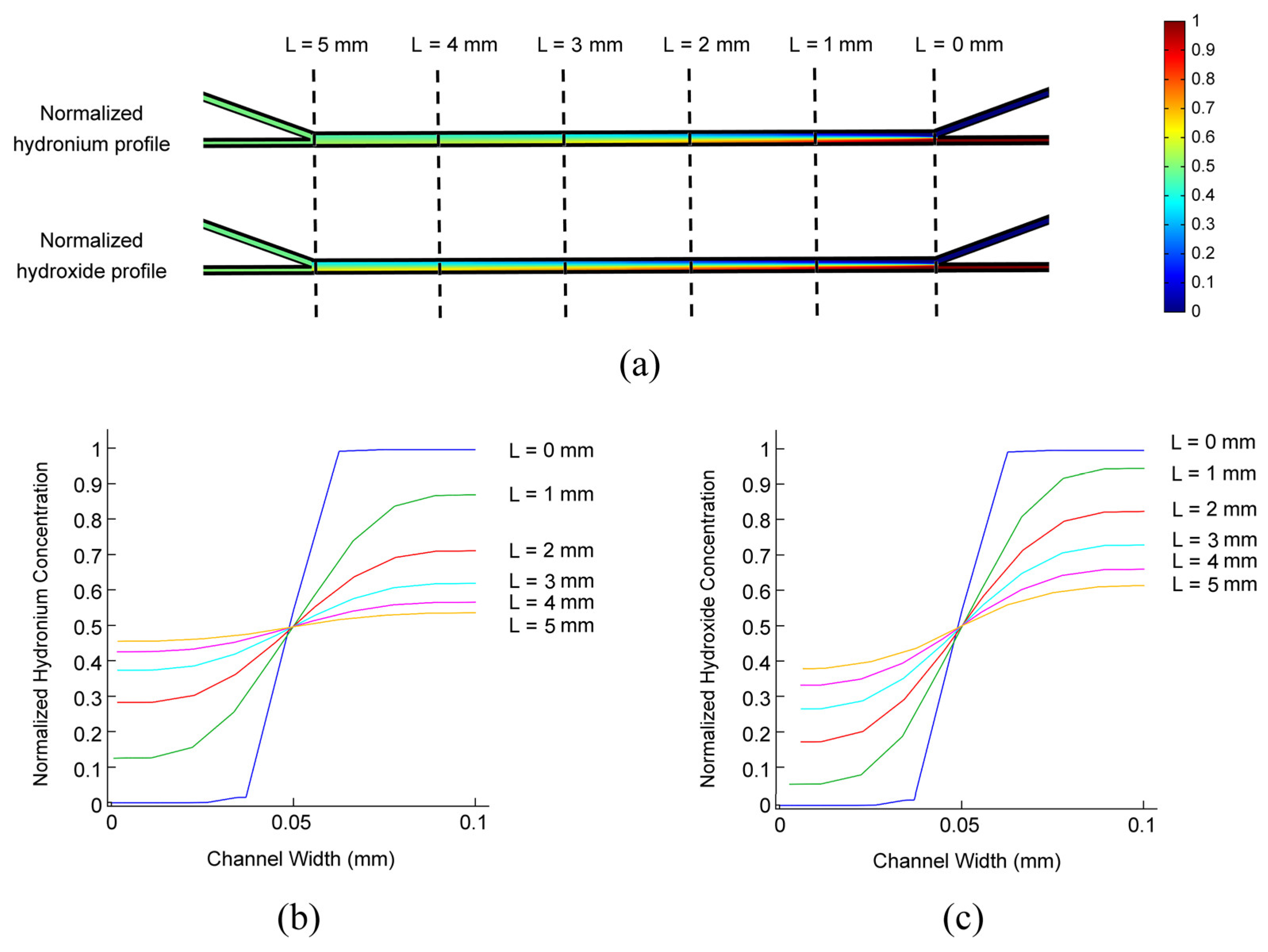


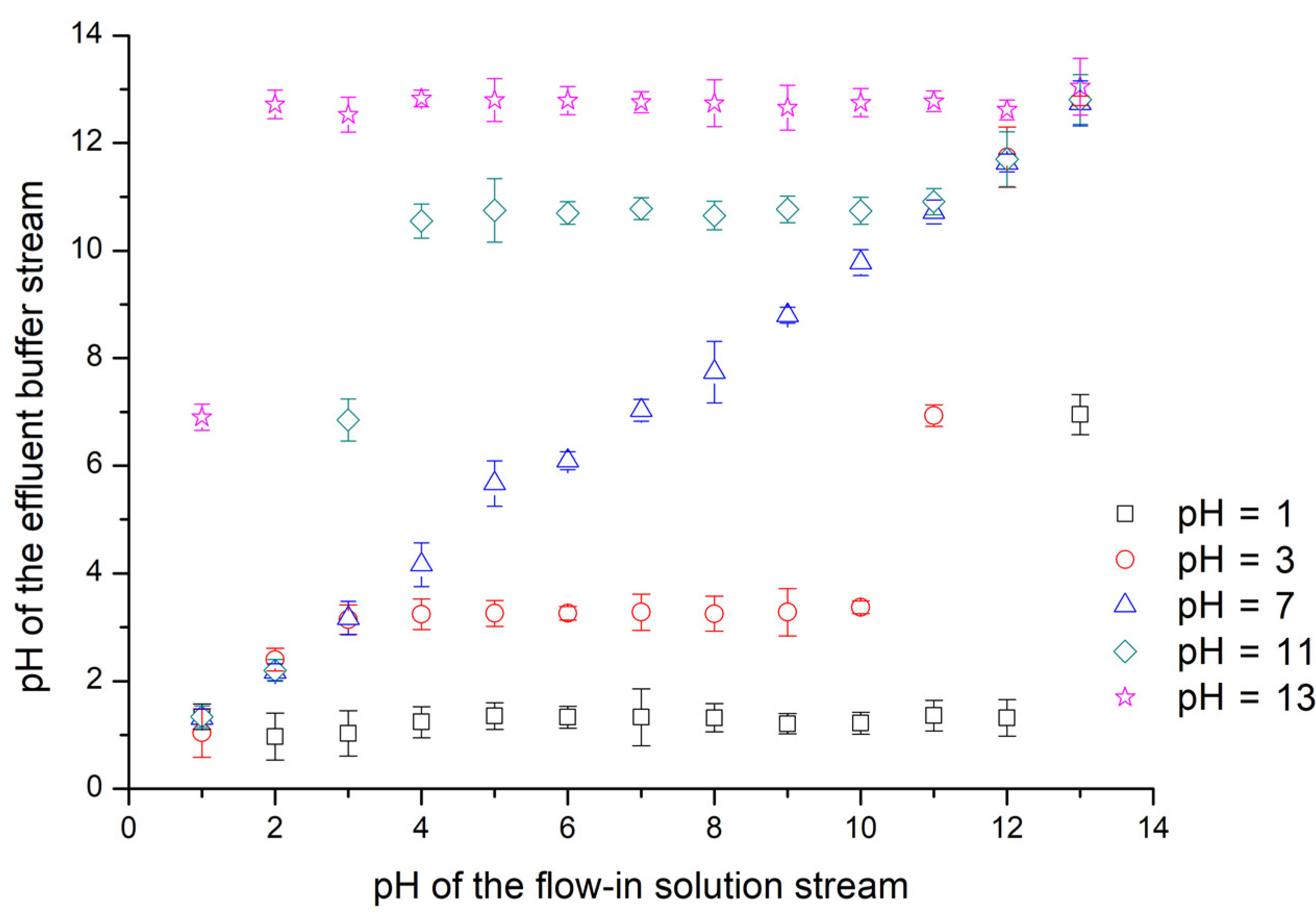

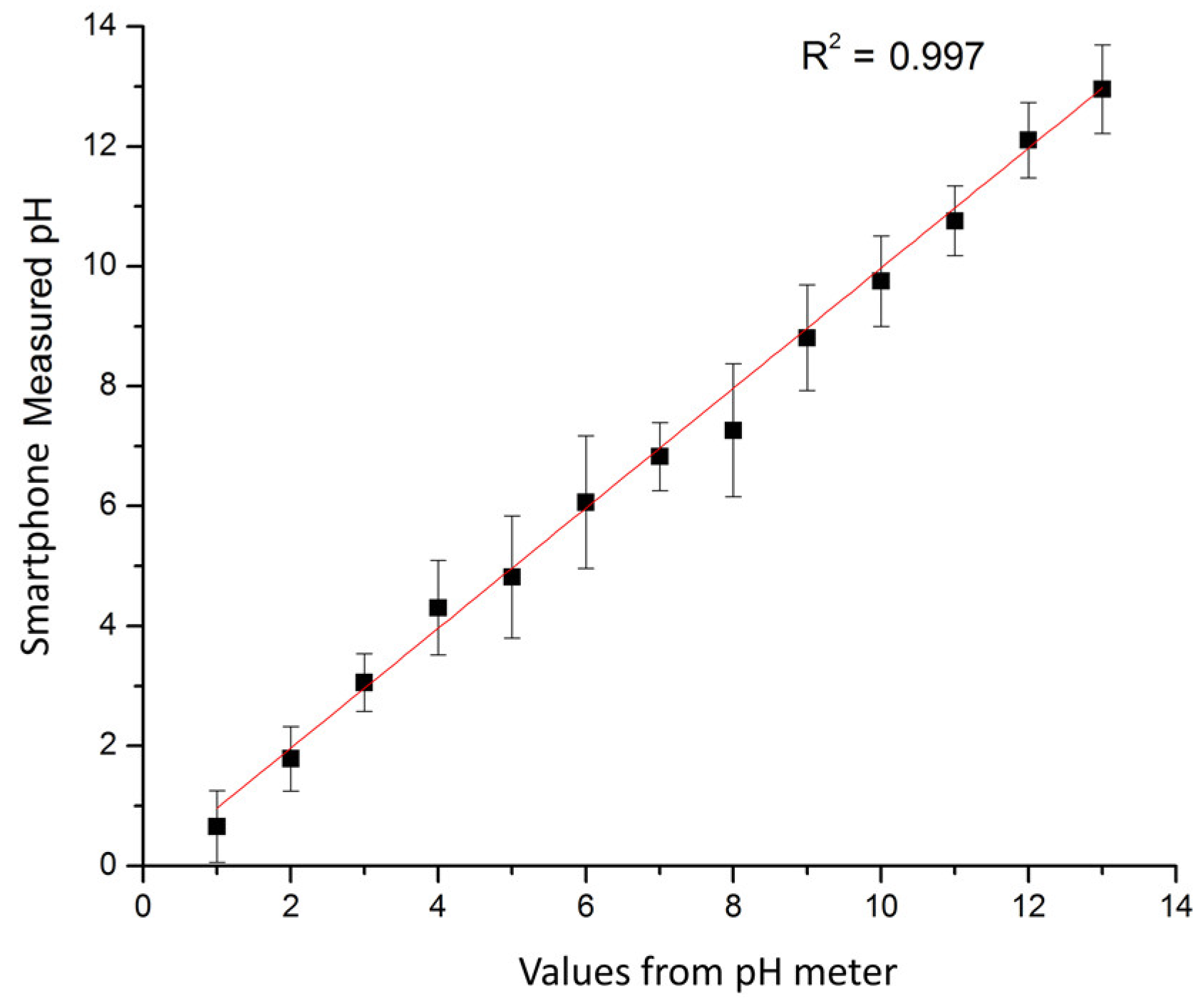
© 2018 by the authors. Licensee MDPI, Basel, Switzerland. This article is an open access article distributed under the terms and conditions of the Creative Commons Attribution (CC BY) license (http://creativecommons.org/licenses/by/4.0/).
Share and Cite
Wang, W.; Zeng, Z.; Xu, W.; Wu, W.; Liang, W.; Zhou, J. A Diffusion-Based pH Regulator in Laminar Flows with Smartphone-Based Colorimetric Analysis. Micromachines 2018, 9, 616. https://doi.org/10.3390/mi9120616
Wang W, Zeng Z, Xu W, Wu W, Liang W, Zhou J. A Diffusion-Based pH Regulator in Laminar Flows with Smartphone-Based Colorimetric Analysis. Micromachines. 2018; 9(12):616. https://doi.org/10.3390/mi9120616
Chicago/Turabian StyleWang, Wei, Zhi Zeng, Wei Xu, Wenming Wu, Wenfeng Liang, and Jia Zhou. 2018. "A Diffusion-Based pH Regulator in Laminar Flows with Smartphone-Based Colorimetric Analysis" Micromachines 9, no. 12: 616. https://doi.org/10.3390/mi9120616
APA StyleWang, W., Zeng, Z., Xu, W., Wu, W., Liang, W., & Zhou, J. (2018). A Diffusion-Based pH Regulator in Laminar Flows with Smartphone-Based Colorimetric Analysis. Micromachines, 9(12), 616. https://doi.org/10.3390/mi9120616




